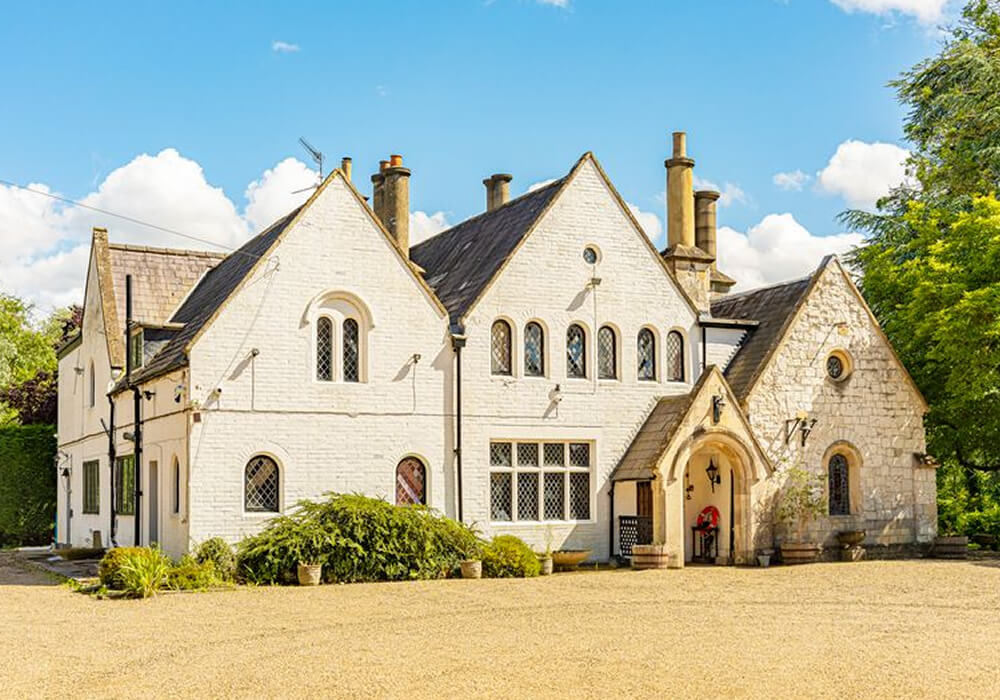
Property Of The Week: Historic Thames-Side Estate For Sale
30.09.24Presenting a unique opportunity to buy into one of the most important events in British history, Grade II Listed 4,708sq.ft. six bedroom, six reception Magna Carta House, on a secluded private island in the River Thames, incorporating a specially built charter room housing the stone slab on which the ground breaking document is said to have been signed by King John in 1215, is for sale for £4,500,000.
Victorian Magna Carta House sits on the tantalisingly named private Magna Carta Island, near Wraysbury village in Runnymede, accessed by its own small road bridge on the mainland. Less than three miles from Staines-Upon-Thames, the home comes with nearly four acres of lush private gardens, which take in 400 metres of River Thames frontage and a mooring. In the manicured grounds are a tree planted by another royal, Queen Elizabeth II in 1974, on her tour of the UK from nearby Windsor, an 830 square foot detached outhouse with potential to create further accommodation, and a detached garage.

Architecturally elaborate Magna Carta House was originally built in 1834 by George Simon Harcourt, a Conservative politician and High Sheriff of Buckinghamshire, to commemorate the signing and sealing of the Magna Carta. Also known as the ‘Great Charter’, and the first document to put into writing the principle that the king and his government were not above the law, limiting monarchs from exploiting their power, it is today regarded as the cornerstone of democracy and liberty in the English-speaking world.
The basis for the law’s most fundamental concepts including due process, trial by jury and protection against excessive fines, over the past 800-plus years it has influenced many important constitutional documents, including the United States’ Bill of Rights.
Harcourt – backed up by a host of historic experts that came after him in following centuries – believed the 3.72 acre island in the River Thames was the likely location of the signing of the document and that it was here that King John met with the 25 rebellious barons who had encamped on the opposite bank of the river in Runnymede. It is thought Magna Carta Island, with its protective circle of walnut trees, on a gentle curve of the river that would keep hostile long bows out of range was especially chosen, with Richard de Montfichet, then owner of the island, tasked with keeping the Magna Carta safe.
While two-storey Magna Carta House is filled with character and impressive architectural embellishments, from its external gables, open porch, cylindrical stone chimneys to its stained glass features and beamed and panelled reception rooms, it is the Charter Room that history-loving house hunters will find most compelling.

Secured with many locks, the room’s star turn is an octagonal fixed wooden table, commissioned by Harcourt, inset with the rough stone upon which the charter was said to have been sealed. Its inscription commemorates both the event in 1215, and the building of Magna Carta House in 1834. Dark wood floorboards, beamed ceilings and a pair of highly detailed, richly coloured stained glass windows add to the sense of period drama, along with the crests of King John and the 25 barons.
The rest of Magna Carta House, while in need of some renovation and refurbishment, is equally impressive. Historic England notes that the originally rather small stone house was given a large extension in the early 20th century, in keeping with the earlier architecture, incorporating Welsh slate roofing, arched leaded windows and reclaimed Jacobean panelling in interior spaces.
Today, beyond the Gothic-inspired arched portico and grand reception hall, several majestic, atmospheric reception spaces flow, including a show-stopping dining room, easily seating up to 20 people for a banquet-style feast, and featuring decorative leaded windows, wooden panelling believed to have been taken from Bisham Abbey, as well as an open fireplace and views across the expansive lawns. The large kitchen has space for a less formal dining area, and there is a further 29ft reception room, study, utility room and guest WC. The Charter Room is also at this level.
Upstairs, on the first floor of Magna Carta House, there are six double bedrooms and two family bathrooms, plus a dedicated dressing room and plenty of built in storage. A secondary, detached five room cottage requires restoration inside and out, but would provide tranquil, luxurious guest or staff accommodation, with the potential for two bedrooms, a reception room, kitchen and bathroom.
The unusually large grounds alone are a huge draw, offering nearly four spellbinding acres of lush lawns fronting the River Thames. They display a number of fine specimen trees, and a striking water feature on an elegant stone terrace, which could easily be converted to use as a swimming pool.
The home also comes with its own private mooring. In Jerome K Jerome’s 1889 humorous water-lovers’ classic, ‘Three Men in a Boat’, he immortalises picturesque Magna Carta Island as a “sweetly pretty part of the river, where it winds through a soft, green valley …” where he intended to “camp in one of the many picturesque inlets to be found round that tiny shore.”
Soren Ravaux, Board Director of WATERVIEW, says: “Grade II Listed Magna Carta House presents a unique opportunity to buy not only the ultimate historic trophy home, designed in 1834 around a commemorative room displaying the very stone on which the Magna Carta was said to have been signed in 1215, but also a unique, four-acre mini-estate in Berkshire with nearly 400 metres of River Thames frontage.
Magna Carta House is available to buy freehold for £4,500,000. For further information or to arrange a viewing, please contact WATERVIEW.
Image courtesy: WATERVIEW
Feature your property by contacting Alan Cox, Abode2, at alan@abode2.com today.
Abode Affiliates
COPYRIGHT © Abode2 2012-2025






















































































































































































































